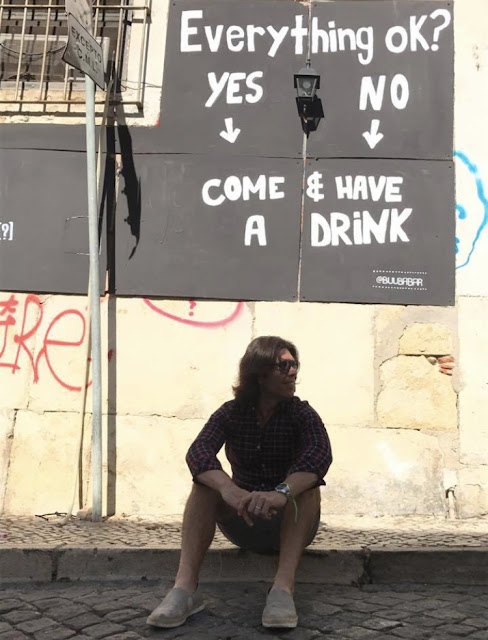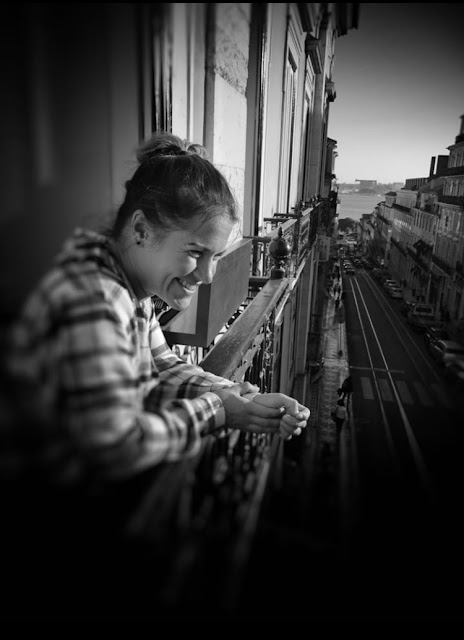Lisbon (Portugal)
21 October – 26 October 2017
There’s a lot to love about
Lisbon. There’s a charm, elegance and a type of ‘time has forgotten’ type of feel to some its parts, then there’s
the bold and modern challengers attempting to make their own statements as to the
future of the city. For me, it’s the city
centre and the warren of streets around Alfama,
sited below the imperious and impressive Castelo de Sao Jorge, that makes this
town what it is. Couple that with Barrio
Alto which feels like the centre of the universe for bars and restaurants
and Baixa which acts as the connector
between these wonderful areas, and my, you have the makings of a mighty fine
city full of beauty, beguiling charm and some other intangible quality that
lets you breath it in fully.
Baixa - Lisbon - Portugal
Barrio Alto - Lisbon - Portugal
View over Baixa to Alfalma and Castelo De Sao Jorge - Lisbon - Portugal
For me personally, I love Alfalma, a labyrinth and maze of narrow
streets that seems to wrap around the base of the hill where Castelo de Sao
Jorge resides. It’s atmospheric and contains a part of Lisbon that in many ways
is now the ‘oddity’ of the city rather than what’s common place, but in that
sense, that’s the way cities are these days, those older, more genuine, authentic areas are no longer that, they’re
relics that are preserved for tourists and as such are become parodies of their
former, younger selves.
We occupied a room in a lovely
boutique hotel on the border of Baixa and Barrio Alto. Perfectly located and
quite handy for the view out to the Tagus, which to me, always seems to be
reflecting the sun like glass back into the city and lighting it up in that
typically Iberian way.
Elevador de Santa Justa - Baixa - Lisbon - Portugal
Lisbon - Portugal
View of Lisbon from near Castelo De Sao Jorge - Lisbon - Portugal
View of Lisbon from near Castelo De Sao Jorge - Lisbon - Portugal
Alfalma - Lisbon - Portugal
We had this Jeep for our tour of Lisbon
Alfalma - Lisbon - Portugal
The Magical Mystery, now into its
third city, was not just about arriving at destinations, we had plans to. Quite
a few of them. From food tours, to city tours, to a night of Fado, we were able
to get a look and feel of Lisbon from a number of angles and enjoyed the
culinary delights, of which there are absolutely plenty.
Pastel de nata, I mean how good are these. Portuguese custard tarts
in egg pastry, dusted with cinnamon. Delightful, moreish and just too difficult
to resist. Then there’s the Bolinhos de
bacalau, made from a mixture of potato & codfish, deep fried and
absolutely exquisite. My own favourite and the king of discoveries which came
from our first foodie tour was Bacalhau a
Bras, a dish made from shreds of
salted cod, onions and thinly sliced potatoes, all bound up in scrambled eggs!
This literally was THE BEST, I absolutely loved it. It’s said that the dish was
to have originated in Barrio Alto, which
is not so hard to believe considering this area is your major hub for all
activities nocturnal.
Barrio Alto - Lisbon - Portugal
Torre de Belem - Belem - Lisbon - Portugal
Pastel de Nata - Lisbon - Portugal
Baixa - Lisbon - Portugal
Alfalma - Lisbon - Portugal
Alfalma - Lisbon - Portugal
On another one of our foodie
tours we crossed the Targus to an area named Ginjal and spent some time at a typical restaurant by the name of Farol. It was there we were introduced
to Vinho Verde (Green Wine). This is
white wine that originates from the historic northern province of Minho. These
wines are delightful, fresh, fruity and floral, and somehow just serves as the
perfect accompaniment to Portuguese food.
Barrio Alto - Lisbon - Portugal
ABSOLUTELY
Hard Rock Cafe - Lisbon - Portugal
Barrio Alto - Lisbon - Portugal
Barrio Alto - Lisbon - Portugal
Alfalma - Lisbon - Portugal
Barrio Alto - Lisbon - Portugal
Outside of Lisbon itself we did
take the time to make to the village of Sintra, known for its 19th
Century Romanticist architecture, historic estates, villas and of course
numerous royal palaces. The most well known being the Pena Palace, of the same architectural style, the castle itself occupies
a hill above the town of Sintra and has unbelievable views all the way out to
the Atlantic Coast. Apparently its said that on a clear day it can be seen from Lisbon some 30kms away,
considering its colour scheme I’d say that I’m not entirely surprised. The
build is actually an intentional mix of a variety of styles, Neo-Gothic,
Neo-Islamic, Neo-Renaissance, and also has references to other historical and
significant buildings in Lisbon, such as the Belem tower, which itself if a 16th
century fortification and occupies pride of place on the Targus, in Belem of
course.
National Palace of Pena - Sintra - Portugal
National Palace of Pena - Sintra - Portugal
National Palace of Pena - Sintra - Portugal
National Palace of Pena - Sintra - Portugal
National Palace of Pena - Sintra - Portugal
National Palace of Pena - Sintra - Portugal
National Palace of Pena - Sintra - Portugal
The most westerly point in Europe - Cabo da Roca - Portugal
Cascais - Portugal
Cabo da Roca - Portugal
Now, Lisbon isn’t just ALL GOOD, it has its problems, and it
appears, it has its problems with people like me directly. They are, along with
Venice & Barcelona, one of the
cities pushing back against mass tourism. Damage to residents’ culture,
heritage and day-to-day lives is becoming a substantial issue. Being the victim
of your own popularity is of course detrimental to those that need to work,
live and play in the space every day.
Alfalma - 'Mass Tourism Kills Lisbon'
Apologies, we are killing you softly
Tram 28 Lisbon - such a scenic run
But look for yourself, all tourists...
Baixa/Barrio Alto - Lisbon - Portugal
Barrio Alto - Lisbon - Portugal
Responsible tourism is now ‘a thing’ and the need to factor in
sustainability for the sake of these cherished locations is a must. And to an
extent I get that. Go to Venice, Dubrovnik or the Vatican on any day of the
week and your involvement is nothing more than standing in an endless queue
that progresses slowly around the location you’re visiting. High season in
places like these are brutal…absolutely brutal, so truly, God help the
population that live it day in and day out.
I don’t know what answers Lisbon
will conjure up in its search for balance, all that I know is that we’ll be
back, if in fact we’re welcome.




















